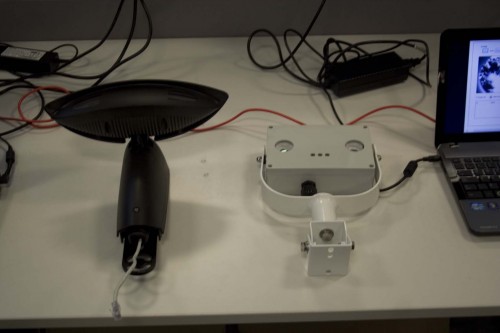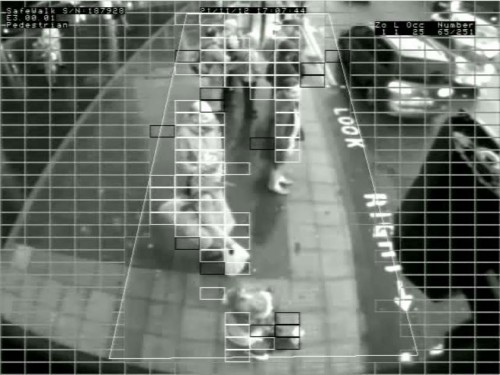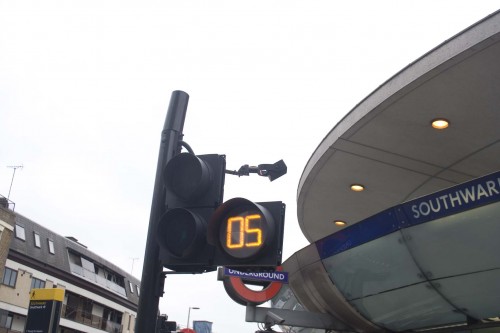You know how it is as a pedestrian, waiting at traffic lights as the little green man lights up, and you look over to the other side, only to see a wall of people heading towards you that you need to navigate your way through.
Busy pedestrian crossing take longer to walk across, because of the inherently chaotic nature of large crowds hurrying to get to the other side of the road.
TfL has come under a bit of fire from some sectors for rephasing traffic lights, seemingly to favour motorists and reduce pedestrian crossing times, but what if a compromise could be found — one that adjusts the traffic lights based on the amount of traffic, and pedestrians who want to use it?
That’s what TfL is about to test — in two locations near tube stations in South London.
Traffic Control
If you watched last year’s series on BBC2 about how TfL monitor buses and road traffic, you’ll know that TfL has a wealth of sensors and cameras to predict where traffic is building up.
What you might not know is that the information is fed into a UK developed software known as SCOOT, and that makes subtle changes to traffic lights to try and ensure a more even flow of road traffic.
However, at the moment, that data is blind to the needs of pedestrians.
But maybe for not very much longer.
In basic terms, a system has been designed that monitors how many pedestrians are waiting at a junction. If there are few, then the pedestrian crossing is left at the default setting. However, if they detect lots of people, and as crowds take longer to cross — add a few seconds to the crossing time.
Two types of sensor will be used during the trials, which will be aware of the number of people waiting at a pedestrian crossing, and depending on how large the crowd is, and depending on the needs of the road traffic, may change how long people have left to cross the road.
The sensors are off-the-shelf equipment that is often used in supermarkets and shopping centres to track shoppers, which have been modified by TfL.

They use stereoscopic vision — essentially 3D viewing — to identify individual “lumps”, which are presumed to be people.
One type monitors crowd density, and can say that the waiting area is a certain percentage full. Another sensor counts numbers of people entering and waiting within the waiting zone.
Three seconds before the crossing light turns green, a decision is taken about the size of the crowd, and either 1, 2, or 3 seconds added to the crossing time.
Note, there is a legal minimum time for pedestrian crossings, so the system would never reduce crossing time, only add to it where needed.
The trial, which starts this summer outside Balham and Tooting Bec Tube stations, will last until the end of the year, and then they will decide if it is a viable technology.
While we already have the push buttons at pedestrian crossings to indicate that someone is waiting there, they have never been able to know how many people are waiting. TfL is thought to be the first organisation to use people tracking technology in this manner to see how many people are waiting to cross the road, and then adjust the crossing time accordingly.
The main uses are expected to be in areas where there can be short lived, unpredictable surges in pedestrians wanting to cross a road — such as outside tube stations, schools or sports venues.

Privacy
Obviously, there will be concerns about yet more CCTVs in London, but for once, the scaremongering will be just that. Scaremongering.
The sensors are deliberately quite low resolution, simply because the tracking software prefers pixilated lumps to high quality video. Also, the video is processed locally within the camera, and the only information that TfL’s central computer gets is the final score when a decision about what to do needs to be taken.
That’s partly for privacy reasons, but also, it is a lot cheaper to only send a simple number score over the backhaul connection than feeding high bandwidth video feeds from traffic junctions everywhere.
The video is also not recorded anywhere, which might disappoint crime prevention sorts, but frankly, the quality of the video we saw wouldn’t be good enough to use anyway.
 A test sensor can be seen mounted on this pedestrian crossing outside Southwark tube station
A test sensor can be seen mounted on this pedestrian crossing outside Southwark tube station
Effect
Essentially, it adds pedestrians into the mix of levers that TfL has control over to try and smooth the flow of traffic across London. Whether the trial is a success, or goes into full production, is something we will have to wait until next year for an answer to.
One day, ever so subtly, how people walk around the city could be as carefully controlled as the trains and buses already are.







At Balham and Tooting Bec it is quite certain that at busy times the pedestrians would be able to cross more quickly if a certain proportion of cyclists in the blue lane did not ignore the traffic lights.
This seems like good use of technology, however I have a bigger problem with pedestrian crossings near to where I live at the other end of the scale when there are not many pedestrians. Pedestrians often press the button when there are no cars and proceed to cross the road with the green man signal. This means that the traffic lights turn red for the cars, stopping traffic when there are no pedestrians to waiting to cross! Its so frustrating waiting at a red signal for no reason. Why do we even need the lights… just put the zebra crossings so that cars only stop when necessary for pedestrians to cross!
The BBC News article about this mentions the development of a ‘call cancel’ function that should deal with that very problem.
I believe we have had that technology in use for more than two years in Australia. I’ve heard,and it seems to be from what I have observed, that it reduces the pedestrian time for the crossing by changing the traffic lights to green once the crossing has cleared of pedestrians.
Sympathise with drivers having to stop at the little green/red man when the pedestrian has already crossed the road – we don’t do it deliberately to annoy, it’s just that a crossing has become clear before the little green man pops up to tell us all is safe.
A system which can monitor the number of people waiting to cross a road sounds brilliant.
It looks to me as if the sensors are up outside Balham tube station.